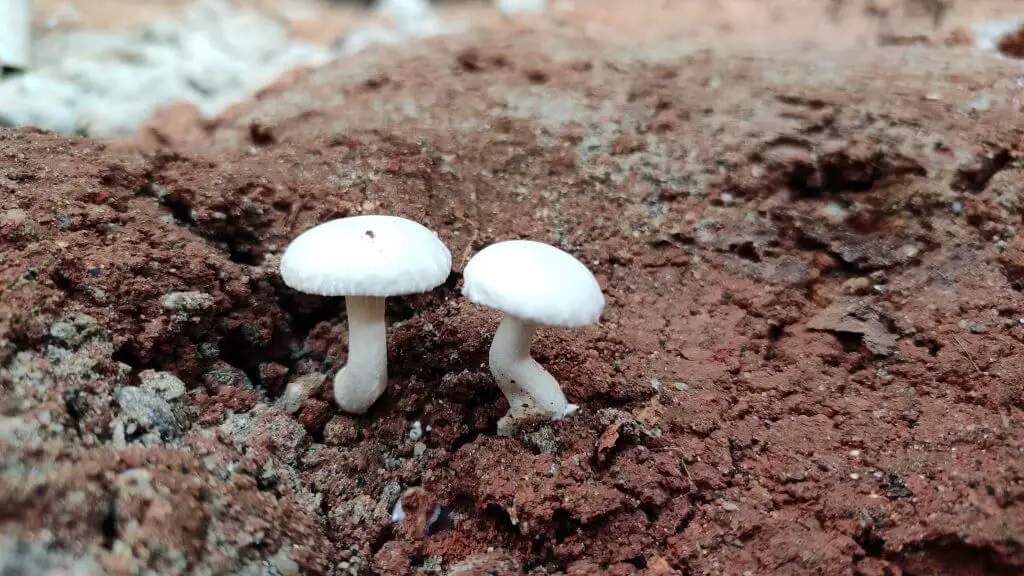Overall, mushroom compost isn't as good for your garden as compost, and your plants won't do as well. Compared to regular compost, mushroom compost has a higher pH and more salts, which may harm young seedlings (and inhibit seed germination).
Read on to learn about mushroom compost, what it is, how to make it, and what to use it for.
Table of Contents
What is mushroom compost?
Even though the term ‘mushroom compost’ implies that this type of compost contains mushrooms, it does not contain mushrooms and has been developed specifically for growing them.
Despite this, mushroom compost can benefit a variety of plants and vegetables, not only mushrooms. It’s a slow-release, organic fertilizer for plants.
Mushroom growers make compost from organic materials like hay, straw, corn cobs, hulls, poultry, and horse manure.
It’s common for the spent mushroom compost to be used for growing mushrooms or other vegetables on smaller scales, such as by home gardeners or as a garden compost in general.
What is spent mushroom compost?
Spent mushroom compost comes from growing mushrooms. It’s used to grow mushrooms for several seasons before it’s sold as compost.
It’s a by-product of mushroom growing, so it doesn’t require any extra resources.
What is in mushroom compost?
Compost for mushrooms can be made of various materials, such as peat moss, chopped straw – typically rye, wheat, or horse bedding straw with horse manure – gypsum, chicken manure, urea, potash, and ammonium nitrate.
Cotton seed hulls, winery grape crushings, and soybean meal may also be included in mixtures.
Is mushroom compost better than regular compost?
Overall, mushroom soil isn’t as good for your garden as compost, and your plants won’t do as well.
Compared to regular compost, mushroom compost has a higher pH and more salts, which may harm young seedlings (and inhibit seed germination).
Since it contains lime, mushroom compost isn’t for salt-sensitive or acid-loving plants.
Compost and mushroom soil are different in a few ways:
- the price
- the nutrient value
- the salt content
- the pH values
- the nitrogen content
| Mushroom compost advantages | Mushroom compost disadvantages |
| Increases soil water retention | Causes waterlogging |
| Slow-release fertilizer | Contains no beneficial microorganism |
| Enhances soil structure and is effective when used as mulch | Causes fungal or root infections |
| High in calcium | It’s high in salt |
| Nitrogen content is mild | Alkaline |
| Attracts earthworms | Some flowers/berries won’t grow in it (blueberries, strawberries, rhododendrons, azaleas, camellias) |
How to use mushroom compost
Mushroom compost can enrich your soil, boost soil quality, and break down dense soil.
1. Mushroom compost can be used as a soil amendment.
It is possible to add organic materials to your garden soil by using mushroom compost.
Additionally, you can use the substrate to enrich vegetable gardens, raised beds, flower gardens, a new lawn, or an orchard.
Top-dress the soil with mushroom compost to improve the soil’s health. It is a slow-release fertilizer, meaning its relatively low nutritional value adds slowly to the soil over time.
2. Mulch can be substituted with mushroom compost.
Adding mushroom compost can also benefit trees and shrubs, so place it around the base of a tree to boost the overall quality of the soil and increase water retention.
3. Clay soil can be broken down using mushroom compost.
Because of its straw content, mushroom compost is particularly effective at breaking down dense, clay-like soils.
4. Mushroom compost is great for growing mushrooms.
By the time mushroom compost is commercially sold, it can no longer produce mushrooms economically. Still, you can grow another crop of mushrooms at home if you keep it in a relatively stable environment with enough moisture (peat can help).
Despite being in smaller quantities, the organic matter in the compost still contains the nutrients necessary for mushroom growth — protein, starch, lignin, fats, and nitrogen.
Mycelium is already present, so it just takes time and care to get a new crop of fruiting heads.
How to make your own mushroom compost
Here’s how you can make mushroom compost on a small scale in your kitchen:
1. Straw is the most popular organic fertilizer for mushroom compost. The straw needs to be chopped up with a wood chipper.
2. Submerge your chipped straw in soapy water and drain it after.
3. Put the straw in a pot of boiling water. It’ll pasteurize.
4. Turn the heat down to 160°F and let it soak for an hour.
5. Let the straw cool on a clean surface.
6. You can plant mushroom spores in straw.
You can also make mushroom compost in a compost bin or a compost heap.
Here’s how:
1. Soak five bales of straw in water, then drain them.
2. Build your compost heap by layering straw, horse manure, and gypsum. Put one bale or straw on top, then 1kg of gypsum and 35kg of manure. Repeat the layering process until you run out of materials.
3. Mix your heap weekly with a shovel to encourage natural breakdown. Mix so that the outer materials move to the center of the heap so they can warm up.
4. When the heap stops producing heat, it’s ready to compost.

